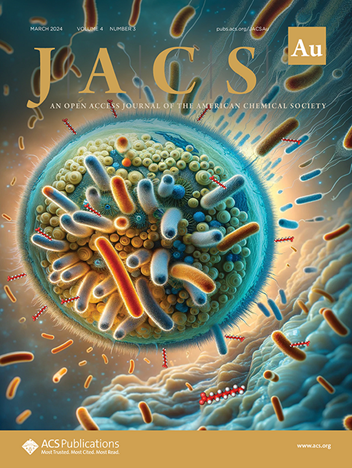New approach for antibiotic development – JUWELS Booster at JSC supported scientists in their research
Hospital pathogens are often particularly dangerous due to their resistance to antibiotics. This also applies to the opportunistic bacterial pathogen Pseudomonas aeruginosa. A research team from Heinrich Heine University Düsseldorf (HHU) and Forschungszentrum Jülich (FzJ) has now found a mechanism that might make it possible to weaken the virulence of the pathogen. Based on this knowledge, a new approach for antibiotics can be developed, as the authors explain in a recent cover story of the scientific journal JACS Au. The scientists also used JSC's JUWELS booster to carry out complicated and highly intensive simulations.
The bacterium Pseudomonas aeruginosa often causes a so-called "nosocomial infection" in humans–i.e. an infection that occurs in the course of a stay or treatment in a hospital or care facility–and is resistant to several antibiotics. The World Health Organisation (WHO) has placed P. aeruginosa on the list of pathogens that require particularly intensive research into treatment options.
The bacterium has a broad spectrum of disease-causing virulence factors, i.e. mechanisms that support the bacterium in causing pathological changes in organisms. These include a certain type of enzyme attacking the membrane of host cells and disrupting various signalling mechanisms in the cells: The so-called "type A phospholipases" (PLA1). Preliminary work has shown that the enzyme PlaF from P. aeruginosa is such a PLA1 and thus contributes to the virulence of the bacterium.

The research groups of Prof. Dr. Holger Gohlke (IBG-4: Bioinformatics at the FZJ and HHU Institute of Pharmaceutical and Medicinal Chemistry) and Prof. Dr. Karl-Erich Jaeger (HHU Institute of Molecular Enzyme Technology at the FZJ) have now identified molecular mechanisms in which medium-length free fatty acids regulate the activity of PlaF. The researchers carried out molecular simulations and laboratory studies as well as in vivo assays. The computationally intense umbrella sampling and free ligand diffusion molecular dynamics simulations of PlaF and fatty acids were performed on the JUWELS Booster module, exploiting the excellent performance of the AMBER molecular simulation code on GPUs.
All three research approaches showed an indirect effect of the fatty acids on the position of PlaF in the bacterial membrane as well as a direct effect by blocking the active centre of the enzyme. In both ways, the activity of PlaF is reduced. “We were only able to unravel these complex relationships through the interaction of computer-aided and experimental techniques within the framework of the projects funded by the CRC 1208.”, says Prof. Gohlke.
The results provide evidence that the interplay of mechanisms is a regulatory factor for PlaF function and contribute to understanding the regulatory role of fatty acids. They thus open up new perspectives on how PlaF function can be inhibited. Prof Jaeger: “This is a promising approach for developing new antibiotics against P. aeruginosa. These are urgently needed to combat the dangerous pathogens in hospitals.”
Contact: Prof. Dr. Holger Gohlke
Click here to get to the more detailed FZJ article: New approach for antibiotic development (fz-juelich.de)
Reference:
Gentile, R., Modric, M., Thiele, B., Jaeger, K.-E., Kovacic, F., Schott-Verdugo, S., Gohlke, H., Molecular Mechanisms Underlying Medium-Chain Free Fatty Acid-Regulated Activity of the Phospholipase PlaF from Pseudomonas aeruginosa. JACS Au 2024, 4, 958−973.
DOI: 10.1021/jacsau.3c00725
